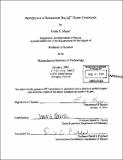| dc.contributor.advisor | Daniel G. Nocera. | en_US |
| dc.contributor.author | Meyer, Emily E. (Emily Elaine), 1979- | en_US |
| dc.contributor.other | Massachusetts Institute of Technology. Dept. of Physics. | en_US |
| dc.date.accessioned | 2005-08-23T22:22:54Z | |
| dc.date.available | 2005-08-23T22:22:54Z | |
| dc.date.copyright | 2001 | en_US |
| dc.date.issued | 2001 | en_US |
| dc.identifier.uri | http://hdl.handle.net/1721.1/8690 | |
| dc.description | Thesis (S.B.)--Massachusetts Institute of Technology, Dept. of Physics, 2001. | en_US |
| dc.description | Includes bibliographical references (leaves 51-52). | en_US |
| dc.description.abstract | Introduction: The ability to determine and characterize the nature of air and fluid flows has become an integral part of numerous industries. In the specific area of airflows, the development of pressure sensitive probes (PSP), molecules sensitive to the pressure of air at a surface, has drawn much attention and is an important area of research and development. Molecules that are currently used for these applications are typically emissive compounds whose emission intensity is quenched by oxygen. This measurement of oxygen concentration at a surface can be used to calculate the pressure, and thus the flow. Although most PSP probes are used at or around ambient temperatures, temperatures in compressors and turbines can be as high as 1000 °C. Therefore, common organic probe molecules are limited due ,o decomposition. All-inorganic polynuclear transition metal cluster ions, on the other hand, lend themselves to these high temperature PSP applications, as they are highly luminescent and exhibit exceptional thermal stability ... | en_US |
| dc.description.statementofresponsibility | by Emily E. Meyer. | en_US |
| dc.format.extent | 52 leaves | en_US |
| dc.format.extent | 3072613 bytes | |
| dc.format.extent | 3072370 bytes | |
| dc.format.mimetype | application/pdf | |
| dc.format.mimetype | application/pdf | |
| dc.language.iso | eng | en_US |
| dc.publisher | Massachusetts Institute of Technology | en_US |
| dc.rights | M.I.T. theses are protected by copyright. They may be viewed from this source for any purpose, but reproduction or distribution in any format is prohibited without written permission. See provided URL for inquiries about permission. | en_US |
| dc.rights.uri | http://dspace.mit.edu/handle/1721.1/7582 | |
| dc.subject | Physics. | en_US |
| dc.title | Photophysics of hexanuclear [Re₆Q₈]²⁺ cluster compounds | en_US |
| dc.type | Thesis | en_US |
| dc.description.degree | S.B. | en_US |
| dc.contributor.department | Massachusetts Institute of Technology. Department of Physics | |
| dc.identifier.oclc | 49753201 | en_US |
